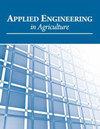联合罂粟收割机样机田间性能的测定
IF 0.9
4区 农林科学
Q4 AGRICULTURAL ENGINEERING
引用次数: 0
摘要
罂粟收割机可用作人工收割的替代品。罂粟收获机的有效田间容量是人工收获的34至53倍。磁场损耗随着前进速度的增加而增加。采用更强力的筛分可以提高清洗效率。手工采集罂粟,然后将其分解,需要大量的劳动和时间,这大大增加了成本。一种用于罂粟收获的机械收割机将节省人力,减少时间消耗。因此,本研究设计了一种罂粟收割机,用于收获和粉碎罂粟胶囊,并从粉碎的材料中分离出茎、种子和蒴果部分。该原型收割机由收获单元、输送单元、脱粒单元、分离清洗单元、装袋单元、动力传输单元组成。机器由牵引车牵引,其运动单元由PTO和液压系统驱动。在样机罂粟收获机的田间试验中,确定了机器的物料容量(种子、蒴果片和总产品)、清洗效率和收获损失。试验采用完全随机区组设计,设3个重复。原型机以1.24 km h-1和1.95 km h-1两种前进速度运行。确定了收获机的有效田间容量比人工收获高34 ~ 53倍,并且增加前进速度,机器容量增加了约50%。在两种前进速度下,清洗效率均约为84%。随着前进速度的增加,磁场损失增加,在13%到21%之间变化。关键词:关键词。清洗能力,田间损失,收获能力,罂粟收割机。本文章由计算机程序翻译,如有差异,请以英文原文为准。
Determination of the Field Performance of a Prototype Combined Poppy Harvester
HighlightsA poppy harvester can be used as an alternative to the manual harvesting.Effective field capacity of a poppy harvester is 34 to 53 times higher than the manual harvest.Depending on the forward speed, field losses increase.Cleaning efficiency can be increased by a more aggressive sieving application.Abstract. The operations of collecting the poppy from the field by hand and then breaking it apart require intensive labor and time consumption, which increases the cost significantly. A mechanical harvester to be used for poppy harvesting will save human labor and reduce time consumption. Hence, a poppy harvester was designed to harvest and crush poppy capsules, and separate the stalks, seeds, and capsule parts from the shredded material with this study. The prototype harvester consists of a harvest unit, conveying unit, threshing unit, separating and cleaning unit, bagging unit, and power transmission unit. The machine is pulled by the tractor and its moving units are driven by the PTO and hydraulic system. In field experiments with the prototype poppy harvester, the material capacity of the machine (seed, capsule pieces, and total product), cleaning efficiency, and harvest losses were determined. The experiments were conducted in a randomized complete block design with three replicates. The prototype machine was operated at two forward speeds of 1.24 km h-1 and 1.95 km h-1. The effective field capacity of the harvester was determined to be 34 to 53 times higher than the manual harvest, and increasing forward speed, increased machine capacity by approximately 50%. The cleaning efficiency was determined to be approximately 84% for both forward speeds. Depending on the forward speed, field losses increased and varied between 13% and 21%. Keywords: Keywords., Cleaning capacity, Field losses, Harvesting capacity, Poppy harvester.
求助全文
通过发布文献求助,成功后即可免费获取论文全文。
去求助
来源期刊

Applied Engineering in Agriculture
农林科学-农业工程
CiteScore
1.80
自引率
11.10%
发文量
69
审稿时长
6 months
期刊介绍:
This peer-reviewed journal publishes applications of engineering and technology research that address agricultural, food, and biological systems problems. Submissions must include results of practical experiences, tests, or trials presented in a manner and style that will allow easy adaptation by others; results of reviews or studies of installations or applications with substantially new or significant information not readily available in other refereed publications; or a description of successful methods of techniques of education, outreach, or technology transfer.
 求助内容:
求助内容: 应助结果提醒方式:
应助结果提醒方式:


